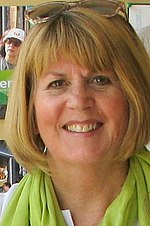Green Party of Canada
| Green Party of Canada Parti vert du Canada Green Party of Canada |
|
|---|---|

|
|

|
|
| Party leader |
Jo-Ann Roberts (interim) President Ken Melamed |
| founding | 1983 |
| Headquarters | 75 Albert Street Suite 305 Ottawa , Ontario K1P 5E7 |
| Youth organization | Young Greens of Canada |
| Alignment |
Green policy environmental protection |
| Colours) | green |
| House of Commons |
3/338 |
| senate |
0/105 |
| Number of members | 20,000 (2016) |
| International connections | Global Greens |
| Website | www.greenparty.ca |
The Green Party of Canada (Engl. Green Party of Canada , French. Parti du vert Canada ) is a Canadian political party . Jo-Ann Roberts has been party leader since November 2019 . The party was founded in 1983.
Political positions
The core idea of green politics is sustainable development . In the political debate, the party often relates the term sustainability to environmental protection and means the conservation of natural resources. This results, for example, in the party's commitment to renewable energies .
On August 30, 2008, Blair Wilson, a Liberal MP , joined the Greens. However, before he could even start a session as the first Green MP, the early general election took place in 2008 . In this, the Greens received 6.8% of the vote; nevertheless they were not represented with a seat in the Canadian lower house after the result of the election due to the currently valid majority voting system, since Wilson lost in his constituency. The party seeks to change the electoral system in Canada.
In the election on May 2, 2011 , Elizabeth May won her constituency on Vancouver Island. She is the first elected member of the Greens in the Canadian lower house. Bruce Hyer joined the Greens on December 13, 2013. Hyer was elected to the House of Commons for the New Democratic Party in 2008 and 2011 . There he had been non-party since 2012. Thus, the Canadian Greens now had two of 308 MPs in the Canadian lower house. In the general election on October 19, 2015 , however, only May was able to defend her seat, so that the Greens fell back to one seat (from 338 now).
In May 2019, Paul Manly won a House of Commons by- election. In the 2019 general election , in addition to Manly and May , Jenica Atwin from New Brunswick also won a mandate. The Greens are represented for the first time with three seats in the Canadian lower house. On November 4, 2019, Elizabeth May resigned as party leader after 13 years in office. Jo-Ann Roberts followed her interim .
Election results
Results of the House of Commons elections:
| choice | seats total |
candidates data |
Weighted seats |
be right | proportion of |
|---|---|---|---|---|---|
| 1984 | 282 | 60 | 0 | 26,921 | 0.21% |
| 1988 | 282 | 68 | 0 | 47,228 | 0.36% |
| 1993 | 295 | 79 | 0 | 32,979 | 0.24% |
| 1997 | 295 | 79 | 0 | 55,583 | 0.43% |
| 2000 | 301 | 111 | 0 | 104.402 | 0.81% |
| 2004 | 308 | 308 | 0 | 582,247 | 4.32% |
| 2006 | 308 | 308 | 0 | 665.940 | 4.48% |
| 2008 | 308 | 303 | 0 | 941.097 | 6.80% |
| 2011 | 308 | 304 | 1 | 576.221 | 3.91% |
| 2015 | 338 | 336 | 1 | 605,637 | 3.45% |
| 2019 | 338 | 338 | 3 | 1,162,361 | 6.50% |
Source: Results of Canadian General Elections since 1867
See also
Web links
Individual evidence
- ↑ Results of Canadian general election since 1867. (No longer available online.) Archived from the original on December 4, 2008 ; accessed on November 22, 2008 (English). Info: The archive link was inserted automatically and has not yet been checked. Please check the original and archive link according to the instructions and then remove this notice.